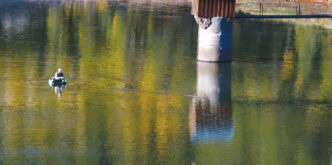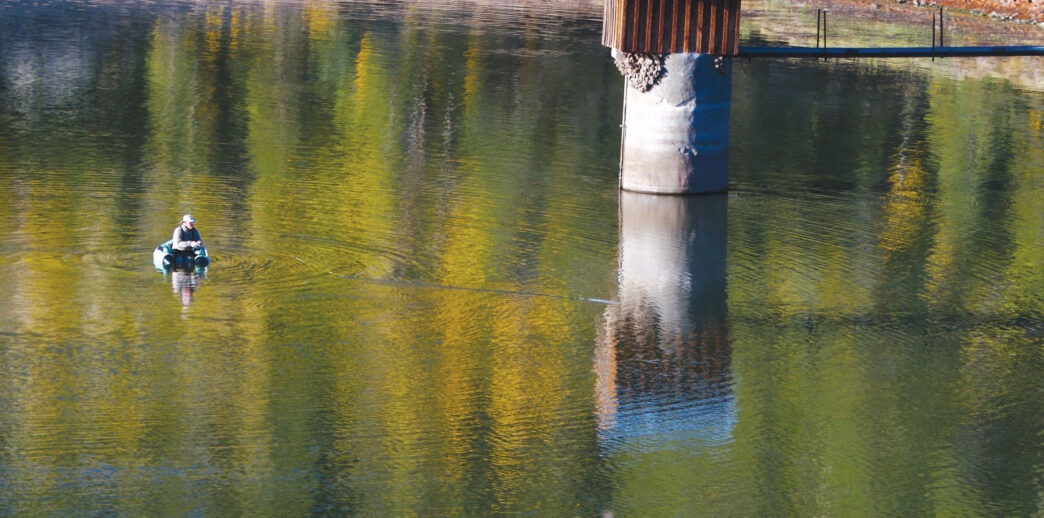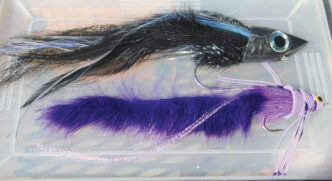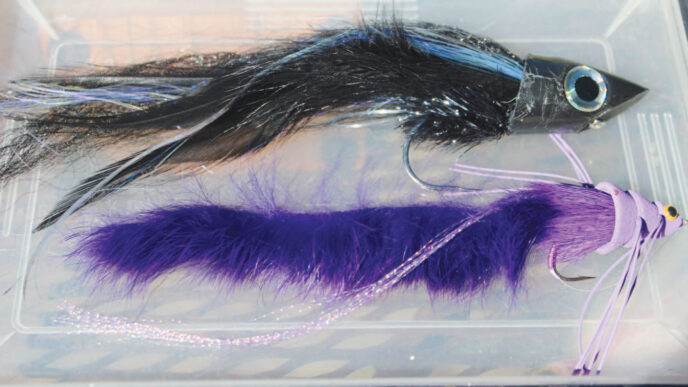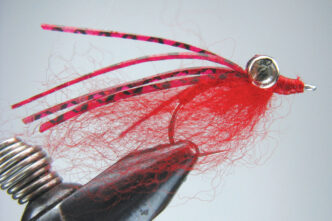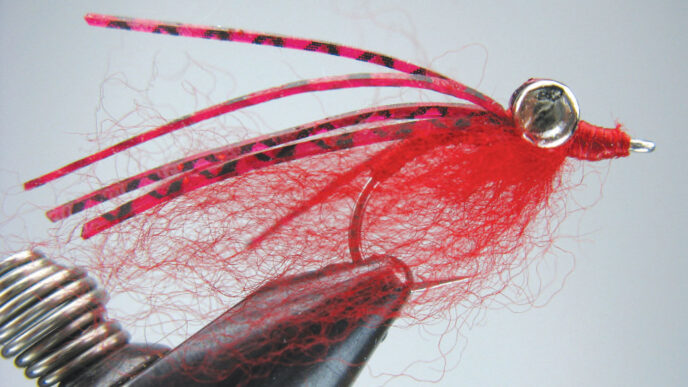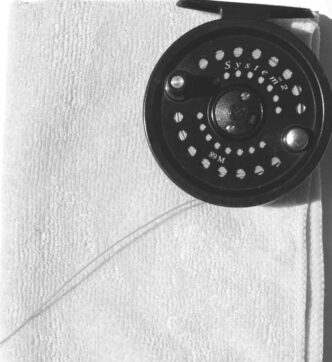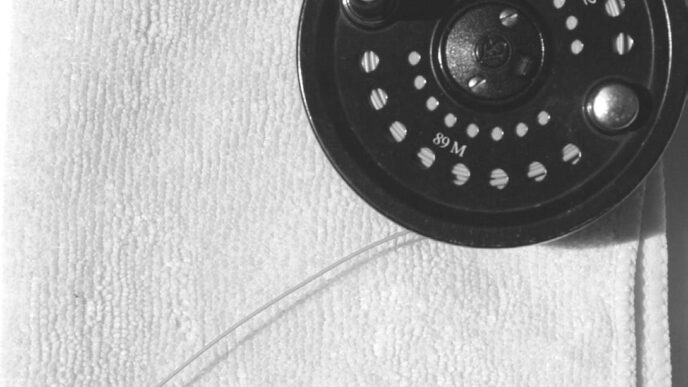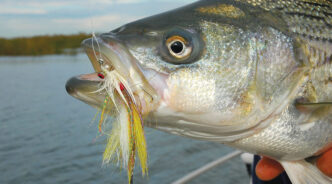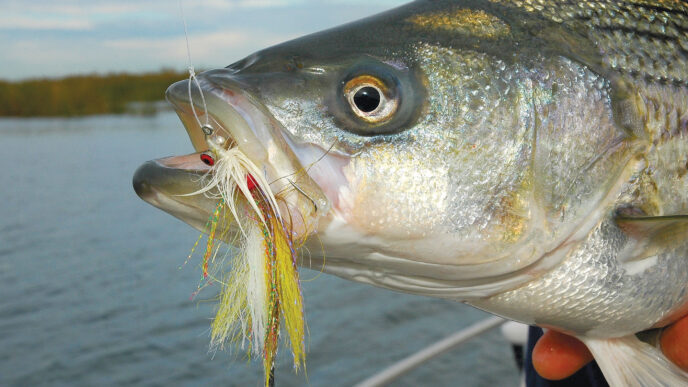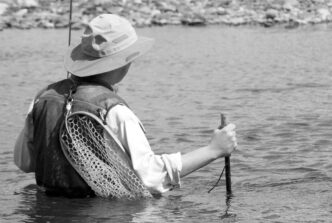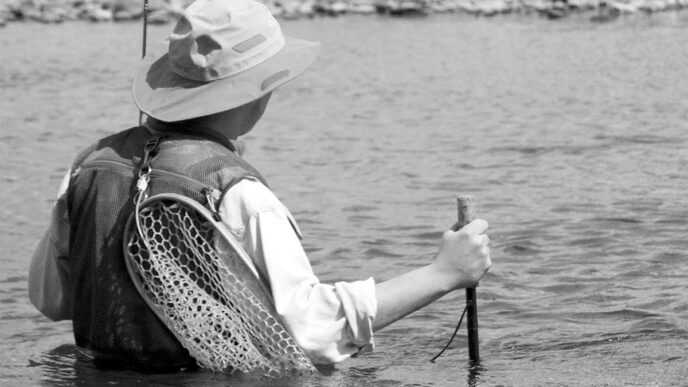We all know that trout in lakes and reservoirs can be extremely selective about what they eat and where and when they feed, which can be frustrating. There are times when it seems as if trout just won’t bite. We have a tendency to blame failure at such times on some unfathomable mysterious mood swing inherent in stillwater trout, but the explanation is not unfathomable or mysterious. Sometimes they in fact won’t bite, but sometimes there are things you can do about it. If you can, it’s because you’ve understood what’s going on and adapted your angling strategy to it.
The more lakes I fish, the more I’m convinced that these so-called “mood swings” are not random fits of trout selectivity, but nearly always the result of external environmental changes most likely created by weather variables. Like streams and rivers, lakes undergo constant physical changes that control trout movement and feeding patterns. The changes are much more subtle in still waters than in flowing waters, but they are just as critical to actually catching fish.
On still waters, subtle environmental changes occur hourly, daily, and seasonally, but fortunately, most major changes develop gradually, which allows attentive anglers to stay on top of these changes as they occur. Putting together an appropriate stillwater strategy thus means making adjustments to what is happening around you by making the correct choice of line, pattern, retrieve, depth, and location. It’s impossible to make a decent presentation to trout that seemingly won’t bite without first understanding how weather and external forces are influencing the behavior of the fish under your fly.
Those conditions are what exist at the moment, not what was happening two hours earlier when you arrived at the lake, or yesterday, or on this day last year. The successful angler is the one flexible enough to adjust to what is happening at the moment and understand its effect on a trout’s feeding behavior. It is the first critical consideration required before fishing.
Adjusting to Change
Making adjustments for weather and environmental conditions is always a vital part of fishing still waters. The anglers who learn what to adjust for and when to make adjustments are the anglers who will consistently catch fish.
Brian Chan, the well-known British Columbia stillwater trout authority and biologist, wrote in his popular handbook Flyfishing Strategies for Stillwater that “the majority of trout lakes undergo seasonal changes similar to the weather we experience. The only difference is we cannot see those changes as they occur underwater.” The effect of weather changes, especially changes in wind, water temperature, and oxygen saturation is well documented. But anglers must focus on other natural changes and disturbances as they occur, as well. All lakes go through so-called “dead periods,” some of which are not related to weather changes, but are tied to seasonal physical changes and natural disruptions. All can produce major changes in a trout bite.
Some changes are easily recognized; others are less obvious. Approaching storm fronts and falling or low barometric pressure affect whether trout will bite, as do moon phases, seasonal lake turnover, sudden swings in water temperature, abrupt changes in water levels, northerly winds, and algae blooms. All of these fluctuations should influence how an angler approaches fishing a lake, and all require that fly fishers adjust what we do to match the feeding behaviors of trout as they react to these changing conditions.
Storm Fronts and Barometric Pressure
In my experience, of all the external conditions that may affect whether trout bite, one of the biggest negative effects is delivered by a low barometric pressure system associated with an incoming weather front. That’s because low barometric pressure has a tremendous effect on trout movement and feeding patterns. If you have fished still waters during springtime conditions, you probably have experienced a swing in a trout bite when an incoming storm front passed through. During stable weather conditions, barometric pressure registers about 30.0. A strong high-pressure system reads about 30.4, and a low pressure system is around 29.7. The size of the swing in barometric pressure is an indicator of just how much effect the system will have on trout behavior. The greater the difference, the greater the effect.
Approaching storm fronts are preceded by falling barometric pressure, and in 30 years of monitoring trout behavior and storm fronts, I’ve discovered some intriguing things. When low pressure sets in, trout become almost totally dysfunctional. As the barometer falls, so does the level of trout activity, especially feeding. I’ve found an approaching front is not only going to send the barometric pressure spiraling downward, but the more severe the front and the more quickly it approaches, the more severely and more quickly it will affect trout behavior. As a result, this is not a good time to pursue stillwater trout. If you must, though, move your fly slowly and fish deep.
Full Moons
Typically, the trout bite begins to nosedive a day before a full moon and fails miserably during the full moon and for two days after. Why are trout so difficult to catch during a full moon? I’ve heard all kinds of theories, opinions, and explanations, but I have yet to meet anyone able to unravel the mystery. The most common assumption is that during a full moon, trout rest during the day and feed all night, although some fish biologists believe trout will briefly feed midday during a full moon. (I don’t know. I haven’t stayed around long enough to find out.) If fish feed at night during a full moon, maybe it is because the moon helps illuminate prey. But if that is true, then why is it that trout sometimes feed voraciously at night during the dark of the moon?
I’ve found that in fact, much as they do during daylight hours, trout feed sporadically at night during a full moon. They go on and off the bite. It is probably true that fish feel more secure feeding under the cover of darkness, and I would agree that they can distinguish an insect silhouetted and illuminated against moonlight, but obviously, there other factors involved that influence feeding patterns during both the day and the night during a full moon. If you are forced to fish in the daytime during the full moon (I avoid it whenever possible), you will find trout are lethargic, passive, and slow to chase food. If I do fish during these periods, I use an intermediate line and suggestive flies in darker colors, and I move them slowly, with foot-long pulls. Most of the fish will be hugging the bottom, so use a line that gets you there quickly, but be prepared for a long, boring day.
Lake Turnover
Lake turnover is a process of water inversion. It occurs only on lakes that are deep enough to have significant temperature stratification at specific depths. I’d hazard a guess that the majority of stillwater anglers do not recognize a lake in turnover and are unaware of the effect that turnover has on trout behavior.
The turnover process, which occurs twice a year, can sometimes be recognized by watercolor — it appears turbid or coffee-stained. In the spring, when lakes are in turnover phase, warm water rises, bringing nutrients to the surface, along with a nasty flush of oxygen-depleted water from the bottom. Eventually, this toxic water is mixed by the spring winds with the warmer, oxygen-rich surface layer until the entire lake from top to bottom will be 39 degrees Fahrenheit. In the autumn, cold, oxygen-deficient bottom water rises to the top and becomes oxygenated and the warmer, already oxygenated surface water settles to the bottom.
A lake in turnover may be responsible for more bad fishing reports than a falling barometer or a full moon. Brian Chan found that “a lake in turnover usually does not fish as well as the overall water chemistry is unbalanced and in particular, oxygen levels are often low throughout the lake.” So, simply put, when a lake turns over, it is not a place you want to fish. Angling options are near zero until the lake rebalances in 5 to 10 days. It is a slow process. The end of the turnover will be marked by the return of clear water. When oxygen levels stabilize, water quality improves and trout renew their search for food. Turnover is complete when trout reappear in the shallow shoreline areas or you begin to catch fish near the surface.
Swings in Water Temperature
Trout behavior depends to a large degree on water temperature, and angling success often hinges on temperature swings. Fish change depths throughout the day, and the depths at which you fish your flies needs to change, as well. Often, this requires swapping fly-line systems and patterns.
Temperature swings are slow to occur and are determined by a number of factors, including a lake’s physical characteristics: depth, input from feeder creeks, artesian springs, nutrient levels, elevation, geographic location, and time of day and season. Dramatic short-term fluctuations can be traced to daily conditions such as sunlight or lack of it, air temperature, rain, snow, or hail. These factors can either cool off a hot bite or trigger one.
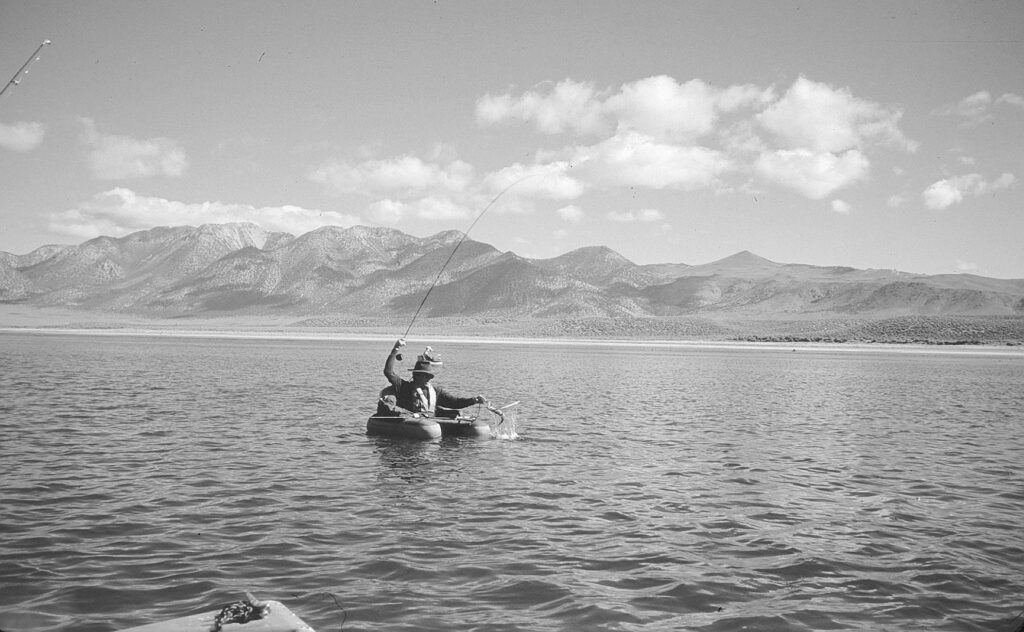
When cold fronts or sudden hot spells arrive, they can cause surface temperatures to fluctuate sufficiently to affect the timing of insect hatches and trout feeding activity. The greater the temperature change, the longer it takes for trout to adjust. Fishing success or lack of it can be altered by as little as a degree or two of change in water temperature, because even that miniscule change requires trout to make adjustments. Their moods are tied directly to these changes, which can take them away from their beats, into the depths and off the bite.
When water temperatures fluctuate drastically, you have few presentation options, and none are good. It is no longer a matter of which line, pattern, or retrieve will bring the magic. There is no magic. When trout really do not want to eat, you are not going to catch them.
If trout are not where you normally catch them, close to the surface or along shallow shoreline edges, it may be a temperature swing that has moved them. If you find them, you can press against the odds by using attractor and suggestive patterns to see what happens.
Fluctuations In Water Levels
Fluctuating lake levels affect presentations to stillwater trout. Normal evaporation or other slow fluctuations are not significant concerns for either trout or stillwater anglers. It is the sudden changes that move trout up and down in the water column and to other locations.
I’ve enjoyed some exceptional angling on lakes where water levels gradually shrank to dangerously low levels by autumn, and I have come to understand that it is not the level of water that counts, but how fast it gets to that level. As it is with most environmental changes, the more rapid the change in water level, the more adverse the effect will be on trout behavior. Reservoirs, more than natural lakes, often endure irregular, horrific changes in depth during the summer as they are used to supply water for cities and towns, agricultural irrigation, and power generation, but oddly, it has been my experience that reservoir trout suffer most not from the drawdowns, but from the refills. I have never, and I mean never, experienced quality angling from spring to fall on a lake that was drawn down low, then refilled the following year. When a lake does not experience those same huge fluctuations in water level for a second consecutive year, it usually will fish extremely well.
Trout need time to adjust, and when feeding patterns are interrupted by rapid water increases, the outcome is predictably bad. Most reservoirs are drained more slowly than they are filled, so the biggest fluctuation takes place in the spring, when the impoundment is being refilled. Lakes reduced to a winter puddle and refilled the following spring from creek inlets, melting snow, or artesian springs almost uniformly offer little hope for anglers at that time. It is a chemistry problem: nutrients need time to settle. The lake water is cold, and trout are scattered and mostly hugging bottom in nonfeeding moods. In a stable lake, the nutrients and solids have time to settle, and temperature and oxygen layers have time to stabilize and stratify. That productive process is slow to materialize with reservoir fluctuations.
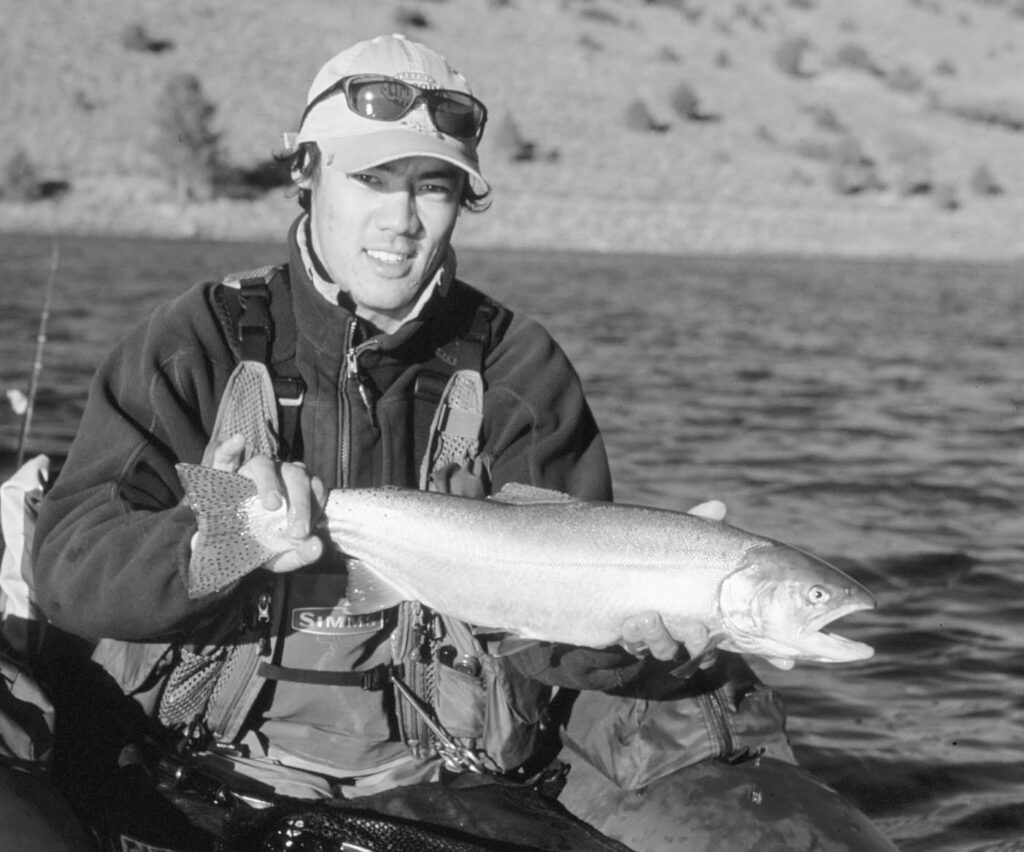
When lake levels drop rapidly, the dominant angling concern is not line, pattern, or retrieve, but locating displaced fish. Reservoir bottoms are generally nondescript wastelands with few holding options. The big exception is the original streambed channel, which by default becomes the best habitat available. Trout are pushed into those channels by desperation more than drawn there by the quality of the habitat. While concentrated in these old channels, the trout become vulnerable to anglers who at full pool find it almost impossible to locate a fishable concentration of trout.
At low water, reservoir trout are looking for any cover they can find. Often, reservoir lunkers will take refuge around submerged stumps, boulders, or any structures they can use to advantage in order to ambush prey without themselves becoming prey for bigger predators. If you have a choice, stick with stable lakes with little fluctuation, compared with reservoirs that have substantial drawdowns each year.
North Winds
Wind has a critical influence on trout, their environment, their feeding behavior, and, most importantly, on the anglers who pursue them. Wind can affect the quality of a trip more than any other element. I have always found it more enjoyable to cast without worrying about wearing the fly in my ear, dumping casts, fighting for line control, or kicking a float tube upwind. Those are just a few of the wind-related things that can wear you down.
Wind, at least in moderation, is not bad and is to be expected. It is the direction and velocity that influence trout behavior and angling strategy. A strong wind affects trout in several ways. Wind dissipates heat and cold, distributes oxygen, aerates surface water, provides cover for both trout and anglers, and usually triggers a bite. But wind from the north is usually associated with cooling air and a highpressure system. Trout don’t like that, and in my experience, they do not choose to feed with any regularity when a north wind blows. I cannot remember ever doing well on trout when a cold north wind was blowing up my shirttail. Some days, I would have preferred a warm fire and a decent chardonnay to the rocking boat.
For the angler, facing into a cold wind is not only unpleasant, it will buffet casts, pile up leaders, and generally is to be avoided. Another failing is that most anglers will turn their back on a cold wind and cast downwind. While that is a little more comfortable and makes casting a lot easier, it is a poor option for making a presentation. The reason is that feeding trout, especially those near the surface, almost always face into the wind to feast on the insects being blown at them. These fish can be spooked by downwind casts that crash into the surface inches over their noses, but more importantly, in a downwind casting position, the angler is in full frontal view of the feeding fish, which are looking directly at the arm-waving angler. It is much more effective to cast across a choppy surface, a casting position that not only hides the line with ruffled water, but shows the trout the profile of the fly and keeps the angler out of a feeding trout’s line of sight.
Algae Blooms
My favorite stillwater lakes are consistent producers of big, well-conditioned trout, and these invariably are lakes that have several environmental features that set them apart from other trout lakes.
Common to all big-trout lakes are extensive shallows that develop nutrient-rich and diverse food chains, coupled with sufficient deep-water areas to create seasonal stratifications and turnovers. The only downside is that the water layers with temperature ranges that are preferred by rainbows, cutthroats, browns, and brookies are thin during the summer months, pushing trout deeper and away from the feeding zones.
On many of these lakes during the hot, calm days of July and August, algae blooms blanket the surface for long periods. Most anglers prefer the ambiance of clear, cold lakes, and that includes me. However, trophies are in the goo, and ignoring algae-clouded water can be a huge mistake. The yuck often hides big, active trout, and there are ways to get at them. My home water, Upper Klamath Lake in southern Oregon, is a prime example. The summer algae is so thick that it sometimes supports commercial algae harvesting, yet it also delivers rainbows of 5 to 15 pounds.
Big-fish specialists need to learn to fish the algae blankets, which should be viewed as just another form of trout cover. Algae blooms are transient, moving in and out of areas, and the density can change hourly, depending upon fluctuations in sunlight. The algae provides security for trout from above-water predators and motivates big trout to move out of the depths and into food-rich shallow-water feeding zones during the middle of the day throughout the dead of summer. It is a rare opportunity for fly fishers. Although the trout that are hunting beneath the cover are unusually large, with rare exceptions, you likely will be fishing for them alone.
Based on years of fishing algae blankets, I am convinced trout do not see more than five or six feet into a heavy bloom. However, they do see the silhouette of your fly just fine. The lack of visibility creates an ambiance of invulnerability for big trout that enhances their predatory nature. Free of the inhibiting fear of becoming prey, big trout can hunt and kill with an abandon rarely seen in shallow water at the height of summer.
After a great deal of experimentation, I have found that slow-sinking intermediate fly lines to be the most effective selection for algae-bloom presentations. I also prefer dark flies, especially bugger and leech patterns attached to 2X or 3X fluorocarbon tippets. Retrieve with slow, deliberate pulls. Trout do not respond well to fast-moving flies in oxygen-thin water. Big trout, especially, have a tendency to trail slow-moving flies, sometimes for yards, before striking. Expect some strikes to occur at the end of retrieves when flies are lifting and about to disappear into the algae.
Putting It All Together
Here’s an example of an instance when assessing the factors that suggest trout won’t bite can lead to success, even under such discouraging conditions. On one of those spring mornings so common on Western lakes, a light northerly breeze was creating a surface chop, enough to cover a sloppy cast and get me by with a short leader and heavy tippet. Selecting a productive presentation was the immediate challenge: when to fish, what to fish, where, and how.
Spring water temperatures on Western lakes often narrow the hot feeding window to midmorning. On this morning, the water temperature registered 46 degrees. Because the water still held the nighttime chill, I knew that mayflies, caddisflies, damselflies, and dragonflies would be late to come off, if they made a showing at all. By eliminating those choices, I was able to narrow my pattern options to a leech, bugger, or minnow imitation. A high overcast meant that the water would be slow to warm and that the sunlight would be muted and not penetrate far into the water column. These conditions typically call for dark patterns that create distinctive silhouettes against a brighter sky.
The weather forecast was for rain later in the day, but the barometer was still holding steady, which meant that trout should still be feeding and not pushed against the bottom by barometric pressure changes. Because the shallow shoreline edges are the first to warm, that’s where I expected to find fish looking for food.
In most shallow lakes, spring water temperatures are colder near the surface, which not only eliminates or delays most hatches, but keeps feeding trout looking for food between four and six feet below the surface, either slightly offshore or in shoal areas. That eliminates surface activity and the need for floating or sink-tip lines. In this situation, my fly line of choice was an intermediate, which offers the diversity required to work shoreline edges as well as the 6-foot-deep hunting zone prior to the appearance of any emerging insects. This morning, after evaluating the external conditions of wind, light, temperature, and food availability, I tied on a Seal Bugger and used slow, foot-long pull retrieves, because the cold water temperature indicated a retrieve with a slow pull no matter which pattern I chose. The presentation worked: six rainbows and a brown
from 18 to 22 inches. How well you fish when factors such as these are in play is tied to your ability to adjust presentations to produce under specific external conditions. This is a critical point that seems overlooked by most fly fishers who target still waters. When trout don’t bite, you don’t always have to give up. Just adjust your presentation.



